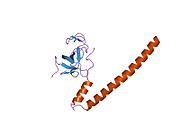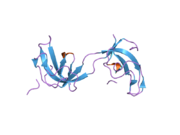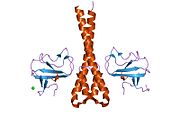Protein-coding gene in the species Homo sapiens
| DCTN1 |
|---|
 |
| Available structures |
|---|
| PDB | Ortholog search: PDBe RCSB |
|---|
| List of PDB id codes |
|---|
1TXQ, 2COY, 2HKN, 2HKQ, 2HL3, 2HL5, 2HQH, 3E2U, 3TQ7 |
|
|
| Identifiers |
|---|
| Aliases | DCTN1, DAP-150, DP-150, P135, dynactin subunit 1 |
|---|
| External IDs | OMIM: 601143; MGI: 107745; HomoloGene: 3011; GeneCards: DCTN1; OMA:DCTN1 - orthologs |
|---|
| Gene location (Human) |
|---|
 | | Chr. | Chromosome 2 (human)[1] |
|---|
| | Band | 2p13.1 | Start | 74,361,154 bp[1] |
|---|
| End | 74,392,087 bp[1] |
|---|
|
| Gene location (Mouse) |
|---|
 | | Chr. | Chromosome 6 (mouse)[2] |
|---|
| | Band | 6 C3|6 35.94 cM | Start | 83,142,902 bp[2] |
|---|
| End | 83,177,099 bp[2] |
|---|
|
| RNA expression pattern |
|---|
| Bgee | | Human | Mouse (ortholog) |
|---|
| Top expressed in | - right frontal lobe
- prefrontal cortex
- right hemisphere of cerebellum
- apex of heart
- anterior cingulate cortex
- nucleus accumbens
- amygdala
- putamen
- caudate nucleus
- anterior pituitary
|
| | Top expressed in | - neural layer of retina
- entorhinal cortex
- perirhinal cortex
- CA3 field
- superior frontal gyrus
- primary visual cortex
- dentate gyrus of hippocampal formation granule cell
- cerebellar cortex
- muscle of thigh
- central gray substance of midbrain
|
| | More reference expression data |
|
|---|
| BioGPS | 
 | | More reference expression data |
|
|---|
|
| Gene ontology |
|---|
| Molecular function | - protein binding
- cytoskeletal motor activity
- microtubule binding
- tubulin binding
- dynein complex binding
- protein kinase binding
- tau protein binding
| | Cellular component | - cytoplasm
- centrosome
- membrane
- dynactin complex
- retromer complex
- cell leading edge
- dynein complex
- microtubule
- cytoskeleton
- kinetochore
- microtubule organizing center
- nucleus
- nuclear envelope
- centriole
- spindle
- cytosol
- actin cytoskeleton
- microtubule plus-end
- spindle pole
- cell cortex region
- cell cortex
- microtubule associated complex
- axon
- neuron projection
- neuronal cell body
- intermediate filament cytoskeleton
- centriolar subdistal appendage
| | Biological process | - antigen processing and presentation of exogenous peptide antigen via MHC class II
- nervous system development
- endoplasmic reticulum to Golgi vesicle-mediated transport
- transport along microtubule
- IRE1-mediated unfolded protein response
- retrograde transport, endosome to Golgi
- G2/M transition of mitotic cell cycle
- melanosome transport
- centriole-centriole cohesion
- positive regulation of microtubule polymerization
- microtubule anchoring at centrosome
- nuclear membrane disassembly
- positive regulation of microtubule nucleation
- ciliary basal body-plasma membrane docking
- non-motile cilium assembly
- mitotic cell cycle
- establishment of mitotic spindle orientation
- regulation of mitotic spindle organization
- cell cycle
- cell division
- regulation of G2/M transition of mitotic cell cycle
- transport
- neuromuscular junction development
- ventral spinal cord development
- neuromuscular process
- motor behavior
- neuron cellular homeostasis
- axonal transport
- maintenance of synapse structure
- positive regulation of neuromuscular junction development
- neuron projection maintenance
| | Sources:Amigo / QuickGO |
|
| Orthologs |
|---|
| Species | Human | Mouse |
|---|
| Entrez | | |
|---|
| Ensembl | | |
|---|
| UniProt | | |
|---|
| RefSeq (mRNA) | NM_001135040
NM_001135041
NM_001190836
NM_001190837
NM_004082
|
|---|
NM_023019
NM_001378991
NM_001378992 |
| |
|---|
NM_001198866
NM_001198867
NM_007835
NM_001347310 |
|
|---|
| RefSeq (protein) | NP_001128512
NP_001128513
NP_001177765
NP_001177766
NP_004073
|
|---|
NP_075408
NP_001365920
NP_001365921 |
| |
|---|
NP_001185795
NP_001185796
NP_001334239
NP_031861 |
|
|---|
| Location (UCSC) | Chr 2: 74.36 – 74.39 Mb | Chr 6: 83.14 – 83.18 Mb |
|---|
| PubMed search | [3] | [4] |
|---|
|
| Wikidata |
| View/Edit Human | View/Edit Mouse |
|
Dynactin subunit 1 is a protein that in humans is encoded by the DCTN1 gene.[5]
Function
This gene encodes the largest subunit of dynactin, a macromolecular complex consisting of 23 subunits (11 individual proteins ranging in size from 22 to 150 kD).[6] Dynactin binds to cytoplasmic dynein, dynein cargo adaptors, and microtubules.[7] It is involved in a diverse array of cellular functions, including ER-to-Golgi transport, the centripetal movement of lysosomes and endosomes, spindle formation, chromosome movement, nuclear positioning, and axonogenesis.
This subunit is commonly referred to p150-glued.[5] It is present in two copies per dynactin complex and forms an ≈75 nm long flexible arm that extends from the main body of dynactin.[6] The p150-glued arm contains binding sites for microtubules,[8] the microtubule plus tip binding protein EB1,[9] and the N-terminus of the dynein intermediate chain.[10][11]
Alternative splicing of this gene results in at least 2 functionally distinct isoforms: a ubiquitously expressed one and a brain-specific one. Based on its cytogenetic location, this gene is considered as a candidate gene for limb-girdle muscular dystrophy.[12]
Interactions
DCTN1 has been shown to interact with:
References
- ^ a b c GRCh38: Ensembl release 89: ENSG00000204843 – Ensembl, May 2017
- ^ a b c GRCm38: Ensembl release 89: ENSMUSG00000031865 – Ensembl, May 2017
- ^ "Human PubMed Reference:". National Center for Biotechnology Information, U.S. National Library of Medicine.
- ^ "Mouse PubMed Reference:". National Center for Biotechnology Information, U.S. National Library of Medicine.
- ^ a b Holzbaur EL, Hammarback JA, Paschal BM, Kravit NG, Pfister KK, Vallee RB (June 1991). "Homology of a 150K cytoplasmic dynein-associated polypeptide with the Drosophila gene Glued". Nature. 351 (6327): 579–83. Bibcode:1991Natur.351..579H. doi:10.1038/351579a0. PMID 1828535. S2CID 4263574.
- ^ a b Urnavicius L, Zhang K, Diamant AG, Motz C, Schlager MA, Yu M, Patel NA, Robinson CV, Carter AP (March 2015). "The structure of the dynactin complex and its interaction with dynein". Science. 347 (6229): 1441–1446. Bibcode:2015Sci...347.1441U. doi:10.1126/science.aaa4080. PMC 4413427. PMID 25814576.
- ^ Cianfrocco MA, DeSantis ME, Leschziner AE, Reck-Peterson SL (2015). "Mechanism and regulation of cytoplasmic dynein". Annual Review of Cell and Developmental Biology. 31: 83–108. doi:10.1146/annurev-cellbio-100814-125438. PMC 4644480. PMID 26436706.
- ^ Waterman-Storer CM, Karki S, Holzbaur EL (February 1995). "The p150Glued component of the dynactin complex binds to both microtubules and the actin-related protein centractin (Arp-1)". Proceedings of the National Academy of Sciences of the United States of America. 92 (5): 1634–8. Bibcode:1995PNAS...92.1634W. doi:10.1073/pnas.92.5.1634. PMC 42574. PMID 7878030.
- ^ Berrueta L, Tirnauer JS, Schuyler SC, Pellman D, Bierer BE (April 1999). "The APC-associated protein EB1 associates with components of the dynactin complex and cytoplasmic dynein intermediate chain". Current Biology. 9 (8): 425–8. Bibcode:1999CBio....9..425B. doi:10.1016/S0960-9822(99)80190-0. PMID 10226031. S2CID 14191776.
- ^ Karki S, Holzbaur EL (December 1995). "Affinity chromatography demonstrates a direct binding between cytoplasmic dynein and the dynactin complex". The Journal of Biological Chemistry. 270 (48): 28806–11. doi:10.1074/jbc.270.48.28806. PMID 7499404.
- ^ Vaughan KT, Vallee RB (December 1995). "Cytoplasmic dynein binds dynactin through a direct interaction between the intermediate chains and p150Glued". The Journal of Cell Biology. 131 (6 Pt 1): 1507–16. doi:10.1083/jcb.131.6.1507. PMC 2120689. PMID 8522607.
- ^ "Entrez Gene: DCTN1 dynactin 1 (p150, glued homolog, Drosophila)".
- ^ Kim JC, Badano JL, Sibold S, Esmail MA, Hill J, Hoskins BE, Leitch CC, Venner K, Ansley SJ, Ross AJ, Leroux MR, Katsanis N, Beales PL (May 2004). "The Bardet-Biedl protein BBS4 targets cargo to the pericentriolar region and is required for microtubule anchoring and cell cycle progression". Nature Genetics. 36 (5): 462–70. doi:10.1038/ng1352. PMID 15107855.
- ^ Liu JJ, Ding J, Kowal AS, Nardine T, Allen E, Delcroix JD, Wu C, Mobley W, Fuchs E, Yang Y (October 2003). "BPAG1n4 is essential for retrograde axonal transport in sensory neurons". The Journal of Cell Biology. 163 (2): 223–9. doi:10.1083/jcb.200306075. PMC 2173519. PMID 14581450.
- ^ Sahni M, Zhou XM, Bakiri L, Schlessinger J, Baron R, Levy JB (December 1996). "Identification of a novel 135-kDa Grb2-binding protein in osteoclasts". The Journal of Biological Chemistry. 271 (51): 33141–7. doi:10.1074/jbc.271.51.33141. PMID 8955163.
- ^ Short B, Preisinger C, Schaletzky J, Kopajtich R, Barr FA (October 2002). "The Rab6 GTPase regulates recruitment of the dynactin complex to Golgi membranes". Current Biology. 12 (20): 1792–5. Bibcode:2002CBio...12.1792S. doi:10.1016/s0960-9822(02)01221-6. PMID 12401177. S2CID 14031165.
Further reading
- Waterman-Storer CM, Karki S, Holzbaur EL (February 1995). "The p150Glued component of the dynactin complex binds to both microtubules and the actin-related protein centractin (Arp-1)". Proceedings of the National Academy of Sciences of the United States of America. 92 (5): 1634–8. Bibcode:1995PNAS...92.1634W. doi:10.1073/pnas.92.5.1634. PMC 42574. PMID 7878030.
- Paschal BM, Holzbaur EL, Pfister KK, Clark S, Meyer DI, Vallee RB (July 1993). "Characterization of a 50-kDa polypeptide in cytoplasmic dynein preparations reveals a complex with p150GLUED and a novel actin". The Journal of Biological Chemistry. 268 (20): 15318–23. doi:10.1016/S0021-9258(18)82472-3. PMID 8325901.
- Vaughan KT, Vallee RB (December 1995). "Cytoplasmic dynein binds dynactin through a direct interaction between the intermediate chains and p150Glued". The Journal of Cell Biology. 131 (6 Pt 1): 1507–16. doi:10.1083/jcb.131.6.1507. PMC 2120689. PMID 8522607.
- Holzbaur EL, Tokito MK (February 1996). "Localization of the DCTN1 gene encoding p150Glued to human chromosome 2p13 by fluorescence in situ hybridization". Genomics. 31 (3): 398–9. doi:10.1006/geno.1996.0068. PMID 8838327.
- Tokito MK, Howland DS, Lee VM, Holzbaur EL (August 1996). "Functionally distinct isoforms of dynactin are expressed in human neurons". Molecular Biology of the Cell. 7 (8): 1167–80. doi:10.1091/mbc.7.8.1167. PMC 275970. PMID 8856662.
- Sahni M, Zhou XM, Bakiri L, Schlessinger J, Baron R, Levy JB (December 1996). "Identification of a novel 135-kDa Grb2-binding protein in osteoclasts". The Journal of Biological Chemistry. 271 (51): 33141–7. doi:10.1074/jbc.271.51.33141. PMID 8955163.
- Blangy A, Arnaud L, Nigg EA (August 1997). "Phosphorylation by p34cdc2 protein kinase regulates binding of the kinesin-related motor HsEg5 to the dynactin subunit p150". The Journal of Biological Chemistry. 272 (31): 19418–24. doi:10.1074/jbc.272.31.19418. PMID 9235942.
- Korthaus D, Wedemeyer N, Lengeling A, Ronsiek M, Jockusch H, Schmitt-John T (July 1997). "Integrated radiation hybrid map of human chromosome 2p13: possible involvement of dynactin in neuromuscular diseases". Genomics. 43 (2): 242–4. doi:10.1006/geno.1997.4789. PMID 9244444.
- Waterman-Storer CM, Karki SB, Kuznetsov SA, Tabb JS, Weiss DG, Langford GM, Holzbaur EL (October 1997). "The interaction between cytoplasmic dynein and dynactin is required for fast axonal transport". Proceedings of the National Academy of Sciences of the United States of America. 94 (22): 12180–5. Bibcode:1997PNAS...9412180W. doi:10.1073/pnas.94.22.12180. PMC 23743. PMID 9342383.
- Engelender S, Sharp AH, Colomer V, Tokito MK, Lanahan A, Worley P, Holzbaur EL, Ross CA (December 1997). "Huntingtin-associated protein 1 (HAP1) interacts with the p150Glued subunit of dynactin". Human Molecular Genetics. 6 (13): 2205–12. doi:10.1093/hmg/6.13.2205. PMID 9361024.
- Li SH, Gutekunst CA, Hersch SM, Li XJ (February 1998). "Interaction of huntingtin-associated protein with dynactin P150Glued". The Journal of Neuroscience. 18 (4): 1261–9. doi:10.1523/JNEUROSCI.18-04-01261.1998. PMC 6792727. PMID 9454836.
- Karki S, LaMonte B, Holzbaur EL (August 1998). "Characterization of the p22 subunit of dynactin reveals the localization of cytoplasmic dynein and dynactin to the midbody of dividing cells". The Journal of Cell Biology. 142 (4): 1023–34. doi:10.1083/jcb.142.4.1023. PMC 2132867. PMID 9722614.
- Collin GB, Nishina PM, Marshall JD, Naggert JK (November 1998). "Human DCTN1: genomic structure and evaluation as a candidate for Alström syndrome". Genomics. 53 (3): 359–64. doi:10.1006/geno.1998.5542. PMID 9799602.
- Tokito MK, Holzbaur EL (November 1998). "The genomic structure of DCTN1, a candidate gene for limb-girdle muscular dystrophy (LGMD2B)". Biochimica et Biophysica Acta (BBA) - Gene Structure and Expression. 1442 (2–3): 432–6. doi:10.1016/S0167-4781(98)00195-X. PMID 9805007.
- Bingham JB, Schroer TA (February 1999). "Self-regulated polymerization of the actin-related protein Arp1". Current Biology. 9 (4): 223–6. Bibcode:1999CBio....9..223B. doi:10.1016/S0960-9822(99)80095-5. PMID 10074429. S2CID 208851.
- Heimann K, Percival JM, Weinberger R, Gunning P, Stow JL (April 1999). "Specific isoforms of actin-binding proteins on distinct populations of Golgi-derived vesicles". The Journal of Biological Chemistry. 274 (16): 10743–50. doi:10.1074/jbc.274.16.10743. PMID 10196146.
- Eckley DM, Gill SR, Melkonian KA, Bingham JB, Goodson HV, Heuser JE, Schroer TA (October 1999). "Analysis of dynactin subcomplexes reveals a novel actin-related protein associated with the arp1 minifilament pointed end". The Journal of Cell Biology. 147 (2): 307–20. doi:10.1083/jcb.147.2.307. PMC 2174220. PMID 10525537.
- Karki S, Tokito MK, Holzbaur EL (February 2000). "A dynactin subunit with a highly conserved cysteine-rich motif interacts directly with Arp1". The Journal of Biological Chemistry. 275 (7): 4834–9. doi:10.1074/jbc.275.7.4834. PMID 10671518.
- Vancoillie G, Lambert J, Haeghen YV, Westbroek W, Mulder A, Koerten HK, Mommaas AM, Van Oostveldt P, Naeyaert JM (December 2000). "Colocalization of dynactin subunits P150Glued and P50 with melanosomes in normal human melanocytes". Pigment Cell Research. 13 (6): 449–57. doi:10.1034/j.1600-0749.2000.130607.x. PMID 11153697.
External links
- GeneReviews/NIH/NCBI/UW entry on Perry syndrome
PDB gallery
-
1txq: Crystal structure of the EB1 C-terminal domain complexed with the CAP-Gly domain of p150Glued -
2coy: Solution structure of the CAP-Gly domain in human Dynactin 1 -
2hkn: Crystal structure of the CAP-Gly domain of human Dynactin-1 (p150-Glued) -
2hkq: Crystal structure of the C-terminal domain of human EB1 in complex with the CAP-Gly domain of human Dynactin-1 (p150-Glued) -
2hl3: Crystal structure of the A49M mutant CAP-Gly domain of human Dynactin-1 (p150-Glued) in complex with human EB1 C-terminal hexapeptide -
2hl5: Crystal structure of the C-terminal domain of human EB1 in complex with the A49M mutant CAP-Gly domain of human Dynactin-1 (p150-Glued) |
 | This article on a gene on human chromosome 2 is a stub. You can help Wikipedia by expanding it. |

 1txq: Crystal structure of the EB1 C-terminal domain complexed with the CAP-Gly domain of p150Glued
1txq: Crystal structure of the EB1 C-terminal domain complexed with the CAP-Gly domain of p150Glued 2coy: Solution structure of the CAP-Gly domain in human Dynactin 1
2coy: Solution structure of the CAP-Gly domain in human Dynactin 1 2hkn: Crystal structure of the CAP-Gly domain of human Dynactin-1 (p150-Glued)
2hkn: Crystal structure of the CAP-Gly domain of human Dynactin-1 (p150-Glued) 2hkq: Crystal structure of the C-terminal domain of human EB1 in complex with the CAP-Gly domain of human Dynactin-1 (p150-Glued)
2hkq: Crystal structure of the C-terminal domain of human EB1 in complex with the CAP-Gly domain of human Dynactin-1 (p150-Glued) 2hl3: Crystal structure of the A49M mutant CAP-Gly domain of human Dynactin-1 (p150-Glued) in complex with human EB1 C-terminal hexapeptide
2hl3: Crystal structure of the A49M mutant CAP-Gly domain of human Dynactin-1 (p150-Glued) in complex with human EB1 C-terminal hexapeptide 2hl5: Crystal structure of the C-terminal domain of human EB1 in complex with the A49M mutant CAP-Gly domain of human Dynactin-1 (p150-Glued)
2hl5: Crystal structure of the C-terminal domain of human EB1 in complex with the A49M mutant CAP-Gly domain of human Dynactin-1 (p150-Glued)

























